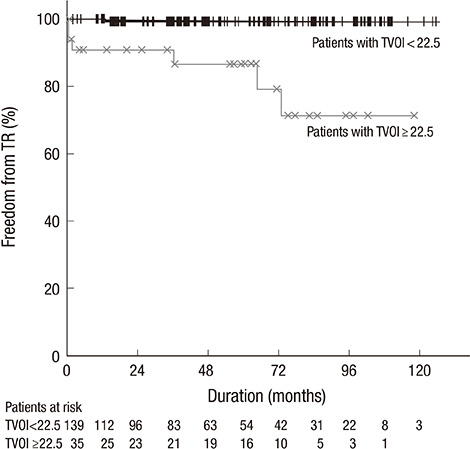J Korean Med Sci.
2013 Dec;28(12):1756-1761. 10.3346/jkms.2013.28.12.1756.
De Vega Annuloplasty for Functional Tricupsid Regurgitation: Concept of Tricuspid Valve Orifice Index to Optimize Tricuspid Valve Annular Reduction
- Affiliations
-
- 1Department of Thoracic and Cardiovascular Surgery, Seoul National University Hospital, Seoul, Korea. ahnhyuk@snu.ac.kr
- 2Department of Thoracic and Cardiovascular Surgery, Samsung Medical Center, Seoul, Korea.
- KMID: 1779416
- DOI: http://doi.org/10.3346/jkms.2013.28.12.1756
Abstract
- We evaluated long-term results of De Vega annuloplasty measured by cylindrical sizers for functional tricuspid regurgitation (FTR) and analyzed the impact of measured annular size on the late recurrence of tricuspid valve regurgitation. Between 2001 and 2011, 177 patients (57.9+/-10.5 yr) underwent De Vega annuloplasty for FTR. Three cylindrical sizers (actual diameters of 29.5, 31.5, and 33.5 mm) were used to reproducibly reduce the tricuspid annulus. Long-term outcomes were evaluated and risk factor analyses for the recurrence of FTR > or =3+ were performed. Measured annular diameter indexed by patient's body surface area was included in the analyses as a possible risk factor. Operative mortality occurred in 8 patients (4.5%). Ten-year overall and cardiac death-free survivals were 80.5% and 90.8%, respectively. Five and 10-yr freedom rates from recurrent FTR were 96.5% and 93.1%, respectively. Cox proportional hazard model revealed that higher indexed annular size was the only risk factor for the recurrence of FTR (P=0.006). A minimal P value approach demonstrated that indexed annular diameter of 22.5 mm/m2 was a cut-off value predicting the recurrence of FTR. De Vega annuloplasty for FTR results in low rates of recurrent FTR in the long-term. Tricuspid annulus should be reduced appropriately considering patients' body size to prevent recurrent FTR.
MeSH Terms
-
Adult
Age Factors
Aged
Body Surface Area
Cardiac Valve Annuloplasty
Disease-Free Survival
Echocardiography
Female
Humans
Hypertension/complications
Male
Middle Aged
Postoperative Complications
Proportional Hazards Models
Recurrence
Risk Factors
Treatment Outcome
Tricuspid Valve/*physiopathology
Tricuspid Valve Insufficiency/etiology/mortality/*surgery
Figure
Reference
-
1. Holper K, Haehnel JC, Augustin N, Sebening F. Surgery for tricuspid insufficiency: long-term follow-up after De Vega annuloplasty. Thorac Cardiovasc Surg. 1993; 41:1–8.2. Kay JH, Maselli-Campagna G, Tsuji KK. Surgical treatment of tricuspid insufficiency. Ann Surg. 1965; 162:53–58.3. McCarthy PM, Bhudia SK, Rajeswaran J, Hoercher KJ, Lytle BW, Cosgrove DM, Blackstone EH. Tricuspid valve repair: durability and risk factors for failure. J Thorac Cardiovasc Surg. 2004; 127:674–685.4. Burma O, Ustunsoy H, Davutoglu V, Celkan MA, Kazaz H, Pektok E. Initial clinical experience with a novel biodegradable ring in patients with functional tricuspid insufficiency: Kalangos Biodegradable Tricuspid Ring. Thorac Cardiovasc Surg. 2007; 55:284–287.5. Navia JL, Nowicki ER, Blackstone EH, Brozzi NA, Nento DE, Atik FA, Rajeswaran J, Gillinov AM, Svensson LG, Lytle BW. Surgical management of secondary tricuspid valve regurgitation: annulus, commissure, or leaflet procedure? J Thorac Cardiovasc Surg. 2010; 139:1473–1482.e5.6. Guenther T, Mazzitelli D, Noebauer C, Hettich I, Tassani-Prell P, Voss B, Lange R. Tricuspid valve repair: is ring annuloplasty superior? Eur J Cardiothorac Surg. 2013; 43:58–65.7. Tang GH, David TE, Singh SK, Maganti MD, Armstrong S, Borger MA. Tricuspid valve repair with an annuloplasty ring results in improved long-term outcomes. Circulation. 2006; 114:I577–I581.8. Sales VL, McCarthy PM. Durability of functional tricuspid valve repair. Semin Thorac Cardiovasc Surg. 2010; 22:97–103.9. Antunes MJ. De Vega annuloplasty of the tricuspid valve. Oper Tech Thorac Cardiovasc Surg. 2003; 8:169–176.10. Akins CW, Miller DC, Turina MI, Kouchoukos NT, Blackstone EH, Grunkemeier GL, Takkenberg JJ, David TE, Butchart EG, Adams DH, et al. Guidelines for reporting mortality and morbidity after cardiac valve interventions. J Thorac Cardiovasc Surg. 2008; 135:732–738.11. Durrleman S, Simon R. Flexible regression models with cubic splines. Stat Med. 1989; 8:551–561.12. Hess KR. Assessing time-by-covariate interactions in proportional hazards regression models using cubic spline functions. Stat Med. 1994; 13:1045–1062.13. Altman DG, Lausen B, Sauerbrei W, Schumacher M. Dangers of using "optimal" cutpoints in the evaluation of prognostic factors. J Natl Cancer Inst. 1994; 86:829–835.14. Chang BC, Song SW, Lee S, Yoo KJ, Kang MS, Chung N. Eight-year outcomes of tricuspid annuloplasty using autologous pericardial strip for functional tricuspid regurgitation. Ann Thorac Surg. 2008; 86:1485–1492.15. Chikwe J, Anyanwu AC. Surgical strategies for functional tricuspid regurgitation. Semin Thorac Cardiovasc Surg. 2010; 22:90–96.16. Morishita A, Kitamura M, Noji S, Aomi S, Endo M, Koyanagi H. Long-term results after De Vega's tricuspid annuloplasty. J Cardiovasc Surg (Torino). 2002; 43:773–777.17. Revuelta JM, Garcia-Rinaldi R. Segmental tricuspid annuloplasty: a new technique. J Thorac Cardiovasc Surg. 1989; 97:799–801.18. Fukuda S, Song JM, Gillinov AM, McCarthy PM, Daimon M, Kongsaerepong V, Thomas JD, Shiota T. Tricuspid valve tethering predicts residual tricuspid regurgitation after tricuspid annuloplasty. Circulation. 2005; 111:975–979.19. Fukuda S, Gillinov AM, McCarthy PM, Matsumura Y, Thomas JD, Shiota T. Echocardiographic follow-up of tricuspid annuloplasty with a new three-dimensional ring in patients with functional tricuspid regurgitation. J Am Soc Echocardiogr. 2007; 20:1236–1242.
- Full Text Links
- Actions
-
Cited
- CITED
-
- Close
- Share
- Similar articles
-
- Repair of Posttraumatic Tricuspid Regurgitation Using Artificial Chordae and an Annuloplasty Ring
- Isolated Tricuspid Regurgitation Caused by Annular Dilatation
- Tricuspid Valve Repair for Tricuspid Valve Insufficiency Following a Cardiac Stab Injury
- Optimal Tricuspid Annular Size for Tricuspid Annuloplasty in Patients with Less-Than-Moderate Functional Tricuspid Regurgitation
- Three-dimensional Reconstruction of Tricuspid Annulus with the Duran Ring




